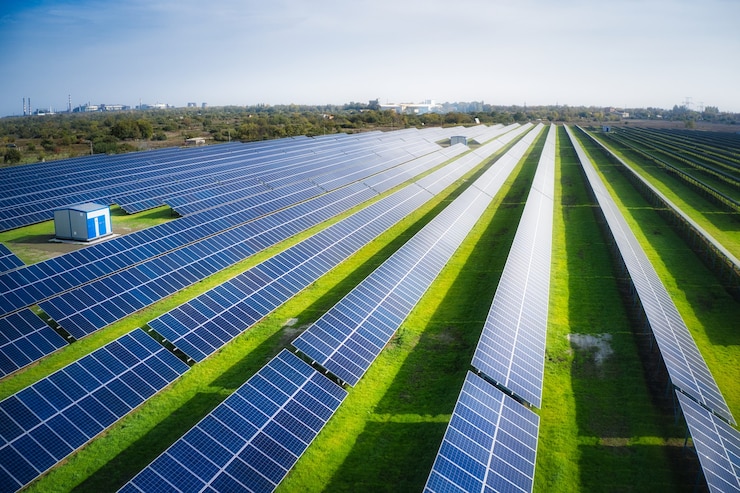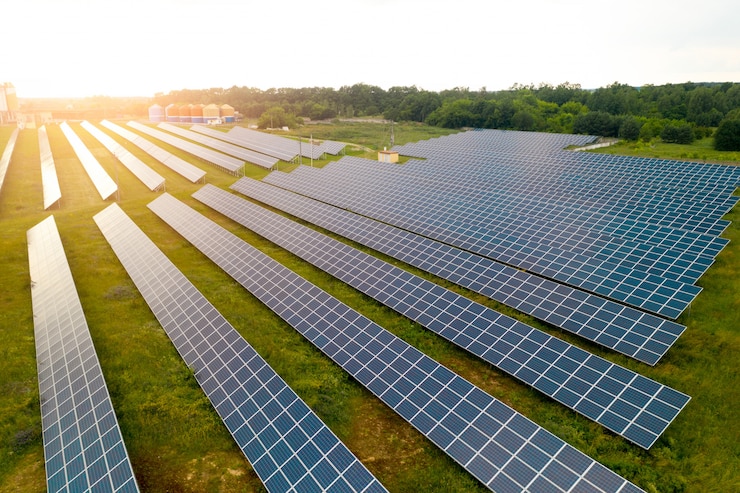What Are Solar Farms and How Do They Work?
Solar energy has changed the way energy companies think about green sources. Solar farms, wind turbines, and water power plants are some renewable energy sources that are getting more attention. Solar energy farms are the most likely to work out of these choices because they only need a little upkeep.
Renewable energy, especially solar energy, is a helpful source with many advantages. Solar farms are the top choice for countries looking to save fossil fuels and reduce carbon pollution. They play a crucial role in supporting sustainable development.
What Is A Solar Farm?

A solar farm is a vast space filled with solar panels. These panels capture sunlight and convert it into solar energy using PV panels. Solar farms, also known as solar power stations and solar solar fields, operate similarly to traditional power plants. However, they differ from rooftop solar or commercial solar systems.
Solar farms generate electricity on a larger scale. They usually construct them in open areas with plenty of sunlight. Solar farms contribute to the production of renewable energy. Solar farms efficiently harness the sun’s energy when situated in rural areas with optimal sunlight exposure.
Functioning like giant power generators, solar farms contribute significantly to power generation on a massive scale. Electric grids distribute the captured solar energy to customers and various stations. Unlike conventional power plants relying on fossil fuels, solar farms provide a sustainable and environmentally friendly alternative, producing electricity without emitting harmful pollutants.
A solar farm is a large power plant that uses sunlight to generate electricity without causing pollution. It helps meet the increasing demand for power.
Types Of Solar Farms

Solar farms come in various types, each catering to specific energy needs and environmental considerations. Two primary categories are utility-scale solar farms and community solar farms.
1: Utility-Scale
Commercial or Utility-scale solar farms are extensive installations comprising thousands of solar panels spread across large areas. These farms generate significant amounts of electricity, contributing to the power needs of entire regions. They operate on power purchase agreements, where companies commit to producing specific quantities of electricity for designated areas.
Large solar farms connect to the power grid, distributing electricity to homes, businesses, and industries efficiently. The scale of these farms varies, providing flexibility to adapt to diverse energy requirements.
2: Community Solar Farm
Community solar plants operate on a smaller scale, producing around 5MW or less. These projects cater to local areas or businesses, allowing participants to share the generated electricity. Community members collectively invest in and benefit from these farms, reducing utility expenses based on the community’s needs.
Developers place solar farms in sunny areas to generate electricity for homes using virtual net metering. Community farms help neighborhoods use sustainable energy together, making sure everyone can be part of renewable energy efforts.
How Does Solar Farm Work?
Solar farms harness the sun’s energy and convert it into electricity through PV panels. Here’s a simplified explanation of how a solar farm works:
1: Sunlight Absorption:
Solar arrays, made with photovoltaic cells, absorb sunlight in daylight. These cells capture photons from sunlight as part of their design.
2: Electricity Generation:
The absorbed sunlight excites electrons within the PV cells, creating a flow of direct current (DC) electricity. This is the initial conversion of solar energy generated into electrical energy.
3: Inverter Transformation:
Inverters convert DC electricity to the standard form, AC, used in homes and businesses. This transformation is crucial for getting along with the existing electrical grid.
4: Grid Connection:
The solar farm connects to the power grid to distribute the generated electricity. This connection enables the solar power plants to contribute power to the grid, benefitting nearby consumers and various stations.
5: Optimizing Sunlight Exposure:
Solar panels on the farm often have tracking systems that adjust their position throughout the day to follow the sun’s path. This ensures maximum exposure to sunlight, optimizing energy production.
6: Large-Scale Power Generation:
Working on a grand scale, solar farms contribute significantly to power generation, providing electricity to electric grids. The company distributes the generated power among customers, contributing to cleaner and more sustainable energy practices.
A solar farm uses sunlight to make electricity, offering a sustainable and environmentally friendly way to produce power.
Advantages of Solar Farms
Solar farms offer numerous advantages, contributing to a sustainable, eco-friendly world. These benefits encompass various aspects, creating positive environmental and user impacts.
1: Environmentally Friendly:
Solar fields rely entirely on renewable sources, utilizing expansive grounds with photovoltaic (PV) panels exposed to sunlight. These farms by themselves generate electricity, getting rid of the need for non-renewable substances like fossil fuels. This approach significantly reduces carbon emissions, contributing to climate change mitigation.
2: Low Maintenance:
Photovoltaic farms require minimal upkeep, with reliable panels lasting up to 20 years. Infrequent cleanup, typically once or twice a year, ensures sustained efficiency. The absence of intricate machinery minimizes technical maintenance, and the farms can store surplus energy during power outages, eliminating the need for additional generators.
3: Less Noise Pollution:
Solar farms exhibit remarkably low noise pollution compared to traditional energy production methods. Unlike noisy machinery in other electricity-producing processes, solar panels operate silently. This ensures a quiet and undisturbed environment for people in the surrounding areas.
4: Technological Advancement:
Solar power technology continuously evolves, adapting to contemporary demands. Scientists anticipate that innovations in the solar industry and quantum physics will significantly enhance the efficiency of solar energy farms. Ongoing technological advancements have the potential to triple the production capacity of solar power systems, making them more effective in electricity generation.
5: Diverse Applications:
Solar farms offer versatile options for power generation, utilizing solar energy for both heat (solar thermal) and light (photovoltaic). Farms can provide electricity to remote areas. They can also assist with cleaning the water.
Additionally, farms can power satellite stations in space. These stations are difficult to reach with traditional power sources.
6: Reduced Bills:
Solar facilities have a high return on investment, especially in monthly electricity bills. Using solar power is affordable, reliable, and lowers maintenance costs, providing customers with a sustainable energy source. Legislative changes and tax incentives also lower the overall cost of building and operating solar farms.
7: Long-Term Success
Solar panels installed for farms offer long-term reliability, getting rid of concerns about energy shortages associated with non-renewable energies. Unlike fossil fuels and machinery-dependent methods, solar farms face no material shortages. Additionally, these farms utilize batteries to store energy, ensuring continuous power availability, even during nighttime hours.
8: Global Impact and Economic Benefits:
Highlight the global impact of solar farms in addressing energy needs and reducing reliance on traditional power sources. Discuss the economic benefits, such as job creation and potential consumer cost savings.
9: Challenges and Solutions:
Solar farms face challenges such as inconsistent energy production and high setup costs. The industry is developing solutions to address these challenges. These solutions aim to improve energy production consistency and reduce setup costs. Discussions on these challenges and solutions are ongoing in the solar farm industry.
10: Government Policies and Future Prospects:
Explore the role of government policies and incentives in promoting the growth of solar farms. Provide insights into the prospects of solar farms, including planning technological advancements, increasing efficiency, and potential expansion into new regions.
Solar Earth Inc Solar Farm Projects in California
Companies increasingly turn to eco-friendly practices by adopting alternative energy, such as solar power, to contribute to environmental preservation. Solar installation emerges as a lucrative business opportunity for entrepreneurs, offering clean energy and environmental keeping going, creating a mutually beneficial scenario.
Don’t hesitate to contact Solar Earth for further insights into solar parks and their environmental impact. We specialize in constructing solar farms for our clients, ensuring a seamless transition to sustainable energy.
Contact Our Friendly, Knowledgeable Staff
Solar Earth Inc., with expertise and certifications, empowers your home for enhanced energy generation. Contact us today to transform your home into a sustainable, long-term renewable energy source.
